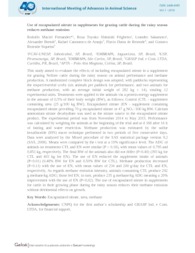Use of encapsulated nitrate in supplements for grazing cattle during the rainy season reduces methane emission.
Use of encapsulated nitrate in supplements for grazing cattle during the rainy season reduces methane emission.
Summary: This study aimed to evaluate the effects of including encapsulated nitrate in a supplement for grazing Nellore cattle during the rainy season on animal performance and methane production. A randomized complete block design was adopted, with paddocks representing the experimental units (six animals per paddock for performance, and two animals for methane production, with an average initial weight of 282 kg ± 14), totaling 12 experimental units. Treatments were applied to the animals via a protein-energy supplement in the amount of 0.5% of their body weight (BW), as follows: Control (CTL ? supplement containing urea (25 g/100 kg BW); Encapsulated nitrate (EN - supplement containing encapsulated nitrate providing 70 g encapsulated nitrate or 47 g NO3?/100 kg BW. Calcium ammonium nitrate decahydrate was used as the nitrate source in the encapsulated nitrate product. The experimental period was from November 2014 to May 2015. Performance was calculated by weighing the animals at the beginning of the trial and at d 168 after 16 h of fasting and water restriction. Methane production was estimated by the sulfur hexafluoride (SF6) tracer technique performed in two periods of five consecutive days. Data were analyzed by the Mixed procedure of the SAS statistical package version 9.2 (SAS, 2008). Means were compared by the t test at a 10% significance level. The ADG of animals on treatments CTL and EN were similar (P = 0.18), with mean values of 0.795 and0.851 kg, respectively. The final BW of the animals also did not differ (P=0.40) (393 kg forCTL and 403 kg for EN). The use of EN reduced the supplement intake of animals(P<0.01) (0.48% BW for EN and 0.50% BW for CTL). Methane production decreased (P=0.11) with the use of EN, with mean values of 234 and 200 g/day for CTL and EN, respectively. As regards methane emission intensity, animals consuming CTL produce 292 g methane/kg ADG; those fed EN, in turn, produce 235 g methane/kg ADG meaning a 20% improvement with the use of EN (P=0,02). The use of encapsulated nitrate in supplements for cattle in their growing phase during the rainy season reduces their methane emission without detrimental effects on growth.
Publication year: 2016
Types of publication: Abstract in annals or event proceedings
Unit: Embrapa Environment
Observation
Some of Embrapa's publications are published as ePub files. To read them, use or download one of the following free software options to your computer or mobile device. Android: Google Play Books; IOS: iBooks; Windows and Linux: Calibre.
Access other publications
Access the Agricultural Research Database (BDPA) to consult Embrapa's full library collection and records.
Visit Embrapa Bookstore to purchase books and other publications sold by Embrapa.

